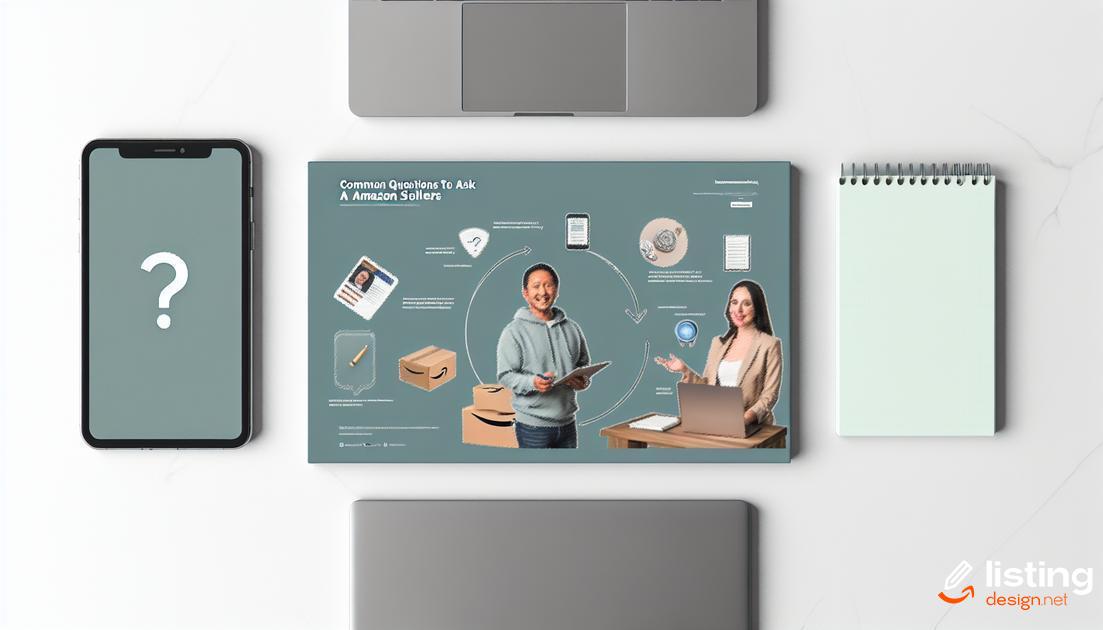Are you struggling with contacting Amazon sellers? Whether you have questions about a product, shipping, or other related issues, reaching out to Amazon sellers effectively can save you time and frustration. This guide provides essential tips for making contact, ensuring your messages stand out, and getting the responses you need quickly. Read on to discover how to enhance your communication with Amazon sellers and resolve your inquiries efficiently.
Table of Contents
Why Contact Amazon Sellers?
When you encounter issues with a product or have specific questions, directly reaching out to Amazon sellers can be beneficial. Fast and clear communication helps address concerns such as product quality, shipping times, and item authenticity. Sellers often provide details not listed on product pages, ensuring you make informed purchasing decisions.
Engaging with sellers can also uncover special deals or discounts. They might offer promotions exclusive to those who show interest in their products. Furthermore, sellers can provide personalized recommendations that cater to your needs.
For sellers, receiving questions can help them improve their listings. Feedback on product descriptions or images can lead to better accuracy, reducing future customer complaints. This back-and-forth benefits both buyers and sellers, creating a transparent shopping environment.
Finding the Seller’s Contact Information

To find a seller’s contact information on Amazon, start by visiting the product page of the item you’re interested in. Scroll down to the ‘Sold by’ section, usually found near the ‘Add to Cart’ button. Here, you’ll see the name of the seller. Click on the seller’s name to be redirected to their storefront.
Seller Profile Page
Once on the seller’s profile page, look for the ‘Ask a question’ button. This is typically located on the right-hand side of the page, under the ‘Further Information’ section. Clicking on this button will allow you to send a message directly to the seller through Amazon’s messaging system.
Alternate Methods
Another way to contact the seller is by navigating to your Orders page if you have already made a purchase. Find the specific order and click on ‘Problem with this order’ or ‘Get help with order.’ From there, follow the prompts to contact the seller.
For sellers listed in the Amazon Marketplace, you can also click on ‘Other Sellers on Amazon’ on the product page, then click on the seller’s name to view their contact options.
Important Considerations
Keep in mind that some sellers may not provide direct email addresses due to Amazon’s policies. Instead, communications are funneled through the platform to ensure privacy and security for both buyers and sellers.
Using Amazon’s Messaging System
Amazon’s messaging system offers a streamlined method for buyers and sellers to communicate directly on the platform. Once you’ve found a seller you’d like to contact, you can simply click the ‘Ask a question’ button on the seller’s profile or product page.
The system ensures all messages remain secure and trackable, providing both parties with evidence of correspondence. This can be especially helpful if there is a dispute or if you need to reference previous discussions.
When using Amazon’s messaging system, be clear and concise in your queries. Sellers often have many messages to attend to, so providing specific details about your inquiry can lead to faster and more accurate responses. Indicate the product name, order number, and any relevant information upfront.
Benefits of Using Amazon’s Messaging System
One significant advantage is that Amazon can monitor the messages, which helps to prevent fraud and maintain a trustworthy marketplace. Additionally, the system offers translation services for international buyers and sellers, breaking the barrier of language differences.
For best practices, respond promptly to any replies you receive and keep your communication professional. Avoid sharing personal contact information or conducting payments outside of Amazon, as this compromises the security benefits provided by the platform.
Remember, timely and respectful communication can enhance your purchasing experience and help build a good rapport with sellers, potentially leading to better service and product recommendations in the future.
Crafting the Perfect Message

Understand Their Perspective
When crafting your message, it’s crucial to consider the seller’s point of view. Sellers are often busy, handling numerous queries alongside their business operations.
Be Clear and Concise
Make sure your inquiry is straight to the point. Avoid long-winded explanations or unnecessary details. State your purpose clearly in the first sentence.
Specify Product Details
Include specific details about the product you’re inquiring about. Mention the ASIN or product name to help the seller quickly identify what you’re asking.
Ask Direct Questions
Pose direct questions that require specific answers. This makes it easier for the seller to provide the information you need without going back and forth.
Maintain a Polite Tone
Always approach the conversation with respect and politeness. Sellers are more likely to respond positively if they feel respected.
Offer Flexibility
Let the seller know you are flexible if you’re asking for something specific, like a delivery date. Offering flexibility shows you are reasonable and considerate of their constraints.
Follow Up Appropriately
If you don’t receive a response within a reasonable timeframe, send a polite follow-up message. Be patient and understand they may need time to reply.
Following Up on Your Inquiry
After sending your initial inquiry, it’s crucial to follow up if you haven’t received a response within a reasonable timeframe. A recommended practice is to wait at least 48 hours before sending a follow-up message. This shows patience and gives the seller enough time to address your query.
When following up, keep your message concise and polite. Reference your previous message and include any necessary order information to make it easy for the seller to locate your inquiry. For instance, you might say:
“Hello, I recently sent a message regarding [specific issue or question] on [date]. I haven’t received a response yet and was wondering if you had an update. Thank you!”
Additionally, you can consider providing multiple ways for the seller to respond, such as suggesting a phone call or alternative email address. This flexibility can sometimes lead to faster resolutions.
Persistence is key, but avoid being overly pushy, as this can strain the relationship. If multiple follow-ups go unanswered within a week, it may be best to look for alternative solutions or contact Amazon’s customer support for further assistance.
Common Questions to Ask Amazon Sellers

Common Questions to Ask Amazon Sellers
When reaching out to Amazon sellers, having a set of questions can help you get the information you need quickly and efficiently. Here are some common questions you might consider asking:
- Product Details: Can you provide more information about the product dimensions, material, and authenticity?
- Shipping: What are the shipping options available and how long will delivery take?
- Availability: Is the product currently in stock and ready to ship?
- Returns and Refunds: What is your return policy, and do you offer refunds?
- Warranty: Does this product come with a warranty or guarantee?
- Customs and Duties: Will I have to pay any customs fees or duties on this item?
- Bulk Orders: Do you offer discounts for bulk purchases or wholesale pricing?
- Alternative Models: Can you recommend any alternative models or options?
- Instructions and Support: Are there instructions or customer support available for setting up or using the product?
Dealing With Unresponsive Sellers
When dealing with unresponsive sellers, it’s essential to remain persistent yet patient. Sometimes sellers can be slow to reply due to high volumes of inquiries, or because they are simply unavailable. Here are some techniques to help you handle such situations:
Check Seller’s Page
Verify if the seller has provided any specific communication guidelines on their store page. Some sellers list preferred contact methods or times when they are most responsive. Adhering to these guidelines may expedite the process.
Use Multiple Channels
If the Amazon messaging system isn’t getting you a reply, try reaching out through any other channels the seller might have listed, such as email or social media. Some sellers may respond more quickly via these alternative methods.
Send Polite Reminders
If you initially contacted the seller a few days ago and have yet to receive a response, send a polite reminder. Keep your tone courteous and reiterate your original question or concern. Respectful follow-ups can sometimes prompt faster replies.
Check for Seller’s Policies
Review the seller’s return and contact policies. This will provide insight into what they prefer for communication and how long they generally take to respond. It can also guide you on the next steps if your inquiry remains unanswered.
Contact Amazon Support
If repeated attempts to contact the seller prove unsuccessful, consider reaching out to Amazon’s customer support. They can sometimes intervene or offer additional contact strategies. Amazon customer support often has more direct ways to prompt a seller’s response.
Leave a Review
In a last resort, leaving a detailed, constructive review on the seller’s page about your experience might get their attention. Be factual and avoid negative language; this isn’t the place to vent anger, but to detail your actual experience with the lack of communication.
Protecting Yourself When Contacting Sellers

Protect Personal Information: Always be cautious about sharing sensitive information like your home address, phone number, or credit card details. Use messaging systems that safeguard your data.
Check Seller’s Reputation: Before contacting a seller, review their ratings and feedback. High ratings and positive reviews are indicators of trustworthiness.
Use Secure Payment Methods: When making a purchase, opt for secure payment methods such as those offered by Amazon. Avoid direct bank transfers or methods that lack buyer protection.
Beware of Phishing Attempts: Be on the lookout for suspicious emails or messages that ask for personal information. Always verify the legitimacy of the communication through official Amazon channels.
Keep Records: Document all communications with the seller, including emails, messages, and transaction details. This will be useful in case of any disputes or issues that arise.
Report Suspicious Activity: If you encounter any fraudulent behavior or scams, report the seller to Amazon immediately. Your vigilance can protect you and other buyers from potential fraud.


